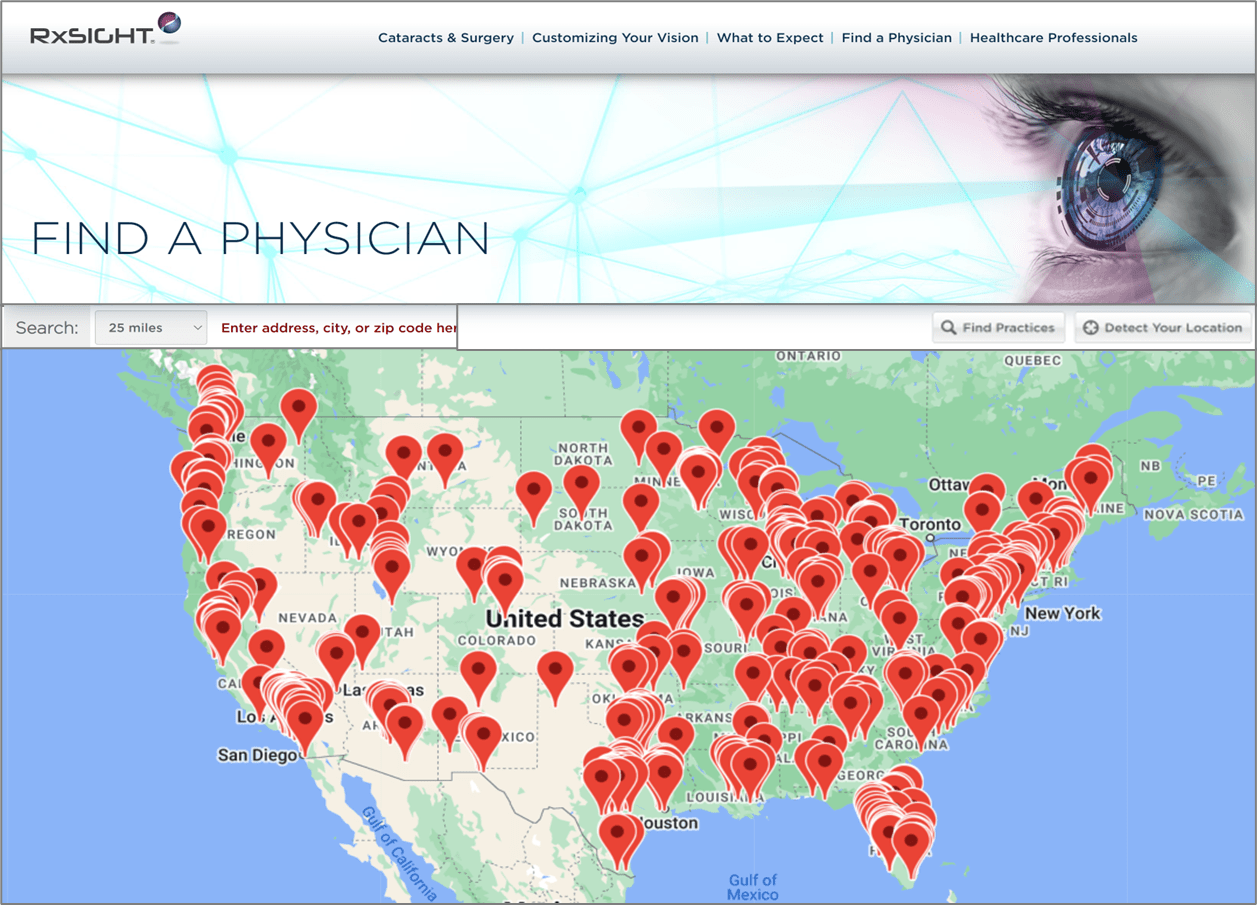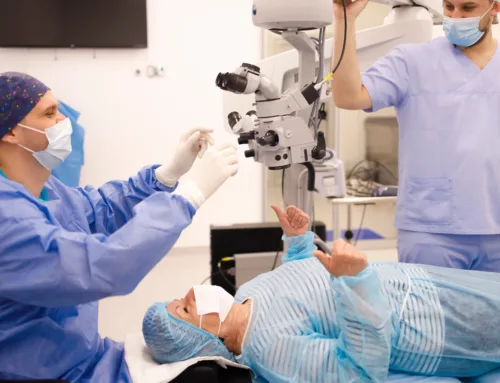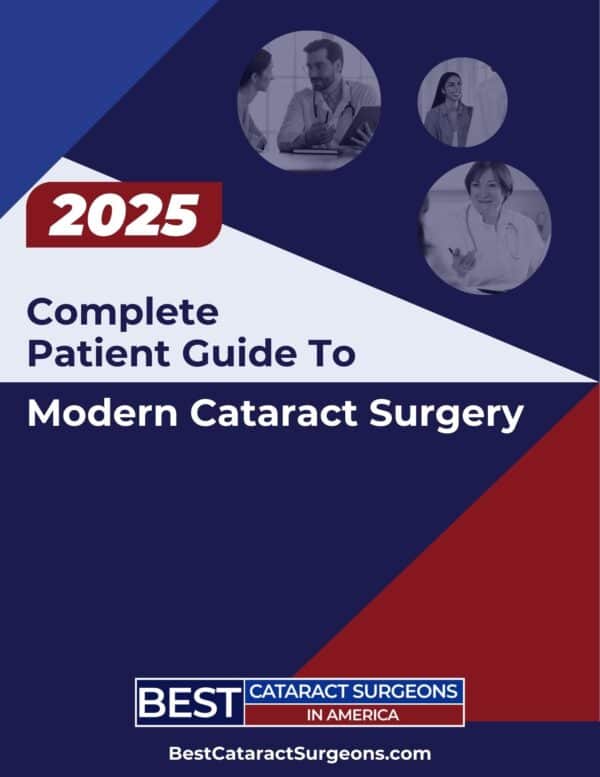The Light Adjustable Lens is a revolutionary lens implant technology that has changed the world of modern cataract surgery for patients and surgeons. The Light Adjustable Lens (LAL) allows surgeons to adjust the prescription of the lens after it’s already inside your eye. This allows patients to achieve superior vision outcomes compared to traditional “fixed” or “non-adjustable” lens implants.
In this article, we’re going to review everything that you need to know as a patient about the light adjustable lens implant.
What is the Light Adjustable Lens Implant?
The Light Adjustable Lens is a first-of-its-kind lens implant used in patients undergoing cataract surgery and custom lens replacement. The lens prescription can be adjusted after it’s implanted in the eye by exposing it to UV light. Traditional lenses are fixed, and can’t have their prescription changed. To understand how amazing this is… first, we need to discuss how things are done with traditional “fixed” or “non-adjustable” lens implants.
Modern cataract surgery allows most patients to not only have blurry vision from their cataracts cleared up… but also to achieve increased freedom from glasses.
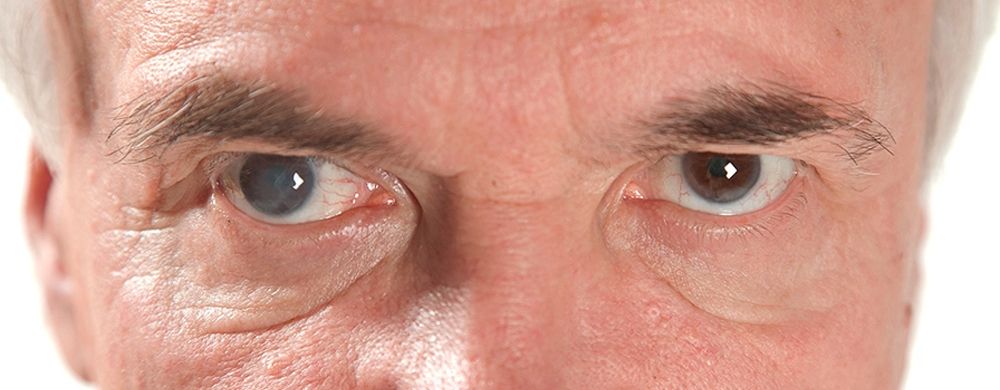
The main reason the prescription of the eye changes after the age of 40 is due to the growth of the natural lens and cataract development. After cataract surgery (i.e. the natural lens is removed), your prescription should remain relatively stable for the rest of your life.
This means that if you are able to achieve independence from glasses with your cataract surgery and new lens implant, it should remain that way permanently.
How To Select Lens Implants
We’ve all had eye exams in which the doctor asks us which lens we like better “number 1 or number 2”. When your eye doctor does this test, called a “manifest refraction”, they are showing you different lens options and allow you to choose which one you like the best. This can be done for glasses or contacts, but it cannot be done in the same way for a lens implant that goes inside your eye.
Everyone gets a lens implant nowadays with modern cataract surgery. If you choose not to get a lens implant, most patients would end up having to wear an extremely thick pair of “coke-bottle” or “aphakic spectacles” which you may have seen in old pictures from the pre-1970, before lens implants were invented.
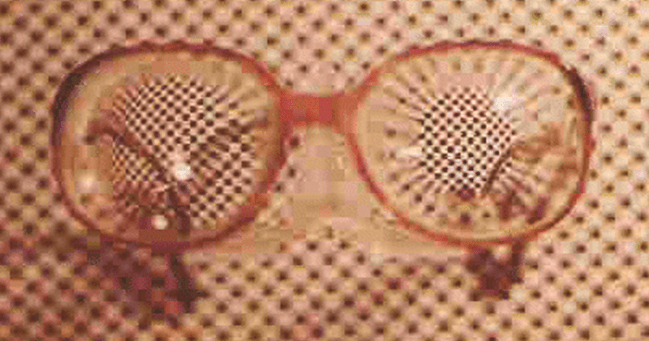
To get your lens implant just right, your surgeon will take a series of measurements on your eye. The key variables are the shape of your cornea, the length of your eye, and the position that your new lens is expected to be after surgery. The modern technology used for selecting lens implants continues to improve… but it’s not perfect.
As a result, despite the best measurement devices on the market, some patients will end up with residual nearsightedness, farsightedness, or astigmatism after their cataract surgery. This would require glasses, contacts, or laser vision correction (e.g. LASIK) after the cataract surgery to fix this remaining prescription.
To fix this problem, the amazing engineers at RxSight developed a lens that can have its prescription adjusted after it’s already inside the eye!
How Does the Light Adjustable Lens Work?
The Light Adjustable Lens technology combines over 20 years of advanced optics, materials science, computing, and photochemistry technologies.
The LAL uses photosensitive material that changes its shape when exposed to a specific wavelength and pattern of light.
![]()
The lens material is a proprietary silicone formulation that uses the photosensitive and photochemical properties of silicon.
Just like other lens implants, measurements are taken before your cataract surgery to choose the prescription of the LAL that’s best for you. However, unlike other lens implants, the LAL’s prescription is adjusted after your surgery.
Approximately 3-5 weeks after your surgery, you’ll come back to your doctor’s office to check your prescription. This is the test in which your doctor asks you whether you like “#1 or #2 better. After your doctor finds your prescription, the light delivery device (LDD) zaps it into your lens implant.
Adjusting your LAL
The Light Delivery Device (LDD) shines a light on your lens implant that causes a reaction within the silicone material of the implant.
The adjustment process is simple and painless and takes approximately 30 seconds to 2 minutes.
Over the 24-48 hours following your adjustment, you’ll notice your prescription change as the silicone molecules in the lens implant redistribute themselves, resulting in the implant changing shape.
Who’s a Good Candidate for the LAL?
The short answer to this question… pretty much everyone.
There is, however, a small minority of cataract surgery patients who are not eligible for the light adjustable lens. One of the requirements is that your pupil dilates sufficiently so that enough of the lens implant is exposed after your surgery for the adjustments. There are also certain medications that cause increased sensitivity to UV light, that are considered a contraindication, which includes tetracycline and chloroquine. (Note: This is not a complete list of medications.)
Other reasons that would prevent a patient from being a good candidate for the LAL would be if you had a history of ocular herpes simplex virus or nystagmus.
If you don’t wall into one of these categories, then you’re probably a great candidate for the light adjustable lens.
While almost everyone is eligible for the LAL, there are some patients who are especially good candidates. Let’s discuss them in the next section.

Who’s an especially good candidate for the LAL?
While most patients are good candidates for the LAL, some patients are really good candidates.
What do we mean by “really good”?
Most patients would like to be free from glasses after their cataract surgery.
There are certain patients for whom traditional lens implant measurements are less accurate. Without being able to adjust the lens implant after surgery, these patients are less likely to achieve their goal of being free from glasses. For these patients, the light adjustable lens is an especially good option. These include patients with a variety of relatively common conditions, such as patients who have had previous LASIK, PRK, or RK surgery, patients with high degrees of nearsightedness or farsightedness, or patients with irregular corneas due to scarring or ectasia.
For patients with any of these conditions who would like the benefit of freedom from glasses after their cataract surgery, the light adjustable lens is a great option.
Is the LAL Good For Patients with Other Eye Conditions?
A common question surgeons get is which lens implant should patients have if they have other eye conditions. Let’s review some of the common eye conditions patients have and discuss how the LAL performs in these conditions.
Is the Light Adjustable Lens good for patients who have had LASIK?
The Light Adjustable Lens is particularly good for patients who have had LASIK in the past. LASIK and these other procedures impact the accuracy of the measurements with traditional lens implants. Having the ability to adjust the lens implant after it’s in the eye dramatically improves the ability to hit the target, and achieve better vision outcomes for these patients.
Is the LAL good for patients with Diabetes?
If diabetes is well controlled, diabetics can be eligible for many different lens implants.
However, no one can predict the future, and when diabetes affects the retina, it can cause vision loss. Vision loss from diabetic retinopathy impairs the performance of many new lens implants, such as diffractive multifocal implants.
The light adjustable lens does not diffract and scatter light in the way that diffractive multifocal implants do, which often makes the LAL a great option for patients with diabetes and cataracts.
Is the LAL good for patients with Glaucoma?
Glaucoma can cause vision loss and the loss of contrast sensitivity. Reduced contrast can cause patients to have a reduced quality of vision. The easiest way to understand this is to explain that patients with reduced contrast vision may be able to see dark black letters on a bright white background in their eye doctor’s office, but the real world is all of those colors and shades of gray in between.
Diffractive multifocal implants impair contrast vision and are typically not used in patients who have moderate to severe glaucoma.
However, the light adjustable lens does not impair contrast and can be a great way to achieve outstanding glasses-free vision in patients with glaucoma and cataracts.
Is the LAL good for patients with Dry Eyes?
Dry eyes can impact the quality and accuracy of the measurements for your lens implant. It is particularly beneficial to have the ability to adjust the prescription of the lens implant after your surgery. Therefore, the LAL is often an excellent option for dry eye patients.
Who makes the Light Adjustable Lens?
The Light Adjustable Lens is made by RxSight based out of California. As of this writing, facilities in Aliso Viejo, California perform all of their manufacturing, assembly, and testing.
What are the Benefits of the Light Adjustable Lens?
The LAL results in better vision after your cataract surgery compared to fixed lens implants that can’t be adjusted.
A study highlighted this benefit, showing that 92% of patients who received the light adjustable lens were 20/25 or better compared to only 60.6% who received a fixed lens implant.
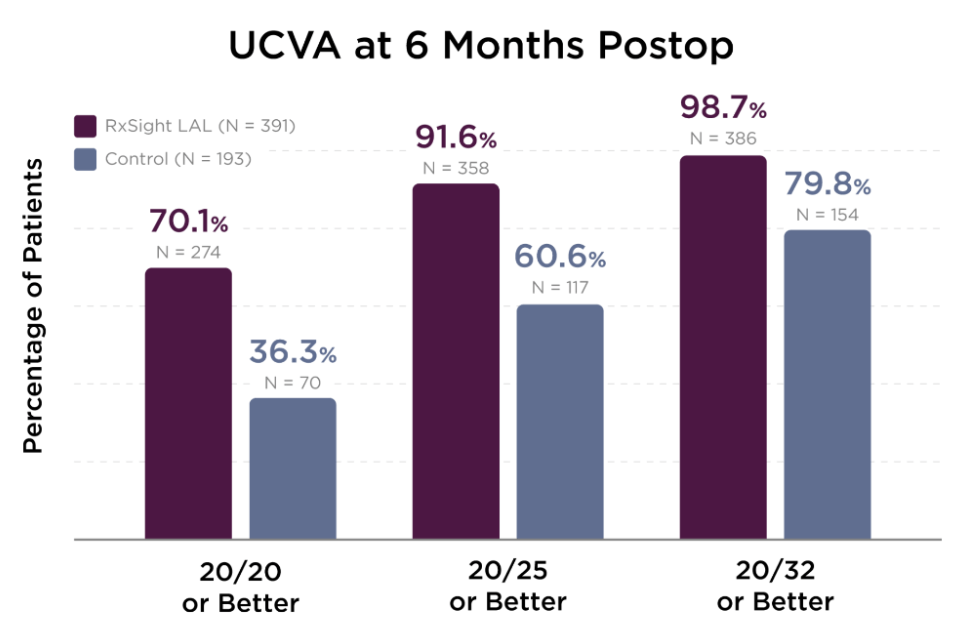
The study above looked at approximately 600 patients who had cataract surgery with either the light adjustable lens or a traditional fixed lens implant. The results were not even close.
Many patients want to have their LAL set for near vision so that they can read without glasses. Some patients prioritize the computer screen or cell phone, while other patients spend their time reading smaller print at a closer working distance.
The LAL allows patients to trial their vision before locking it in. For example, the lens can initially be set a little farther out, and over the course of the adjustment process, it can gradually be brought in closer so the patient can experience their vision before making it permanent.
Are There Any Drawbacks of the LAL?
The LAL requires extra follow-up visits. During the adjustment period, patients wear protective glasses to block UV light.
For some patients who must travel long distances for follow-up appointments these extra visits may be a burden. For patients who are sick or disabled, additional office visits may be a burden. However, in the long run, it may save years of visits for glasses.
These extra visits are an investment in your vision.
Do Light Adjustable Lenses Fix Astigmatism?
Yes… The light adjustable lens fixes astigmatism. At each adjustment visit your eye doctor measures any remaining astigmatism, and will treat it during your adjustment.
In a study evaluating how good the Light Adjustable Lens was at correcting astigmatism, it was compared to the Tecnis Toric and Acrysof Toric lens implants, made by Johnson & Johnson and Alcon, respectively. The Tecnis and Acrysof lenses were two of the most popular toric lens implants on the market. “Toric” lens implants have astigmatism correction built into them.
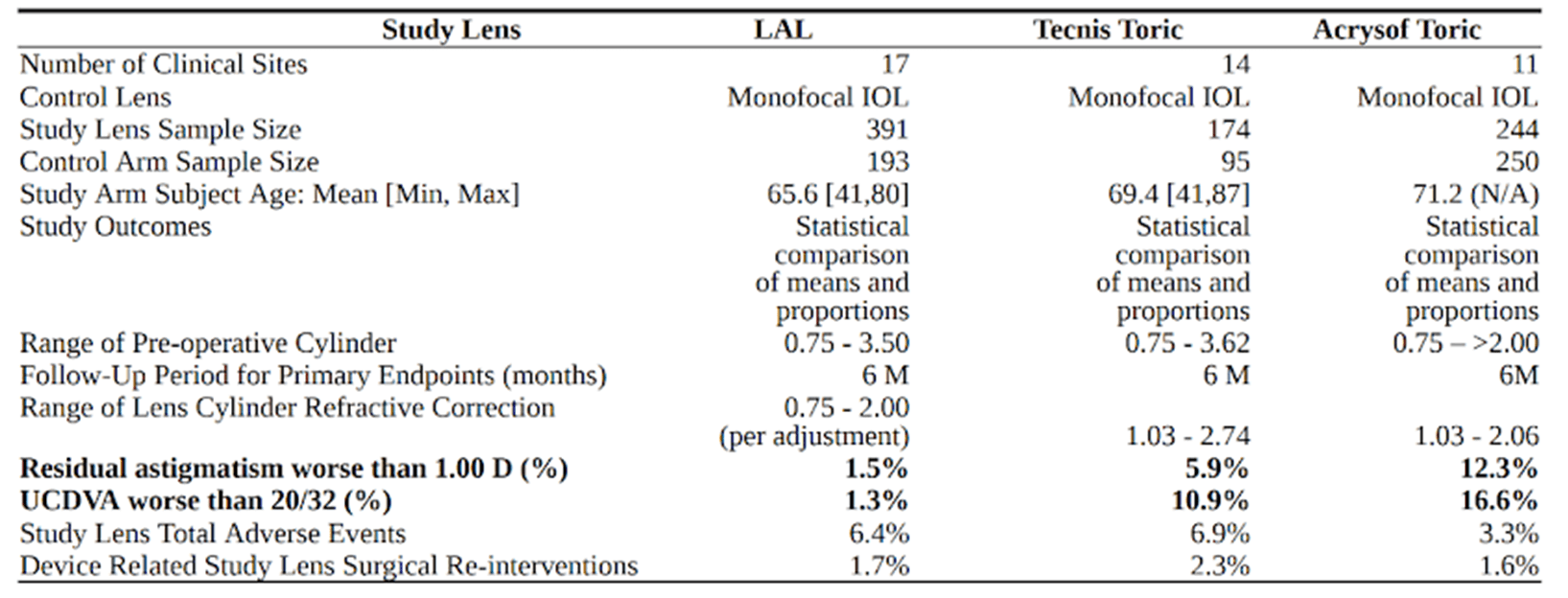
Table: Comparison of Toric IOL Studies using publicly available data for LAL(P160055), Tecnis Toric (P980040/S039) and Acrysof Toric (P930014/Sl5) IOLs from RxSight FY2021 Annual Report.
Perhaps the most important statistic in the table is the percentage of patients with “UCDVA worse than 20/32”. “UCDVA” means “uncorrected distance visual acuity”. In common language, this means “how clear your vision is for distance activities without glasses”. Of course, every patient would like to be perfect 20/20, or even better. But 20/32 is a reasonable cut-off for very good vision that most patients would be quite comfortable with for most of their activities, including driving and watching television.
Remarkably, only 1.3% of patients who received the LAL had UCDVA worse than 20/32, compared to over 10% and 16% for the Tecnis and Acrysof toric lenses.
For patients with up to 3.5 diopters of astigmatism, the LAL proved to be outstanding at achieving excellent distance vision without glasses. The LAL functions like a toric lens implant in these patients.
Do I Really Need to Wear Protective Glasses After My Light Adjustable Lens Surgery?
Yes. Protective glasses are necessary. These glasses should be worn during all waking hours before the final lock-in. The light adjustable lens material is sensitive to UV light. Exposing the LAL to UV-light could change its shape in an uncontrolled way. This could change the prescription of the LAL.
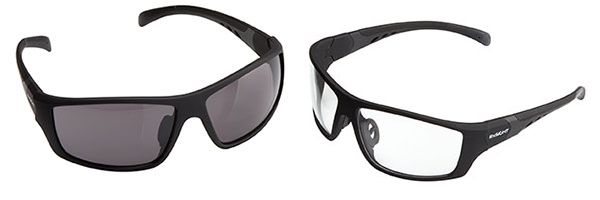
How Much Does The Light Adjustable Lens Cost?
Medical insurance covers cataract surgery, however, the Light Adjustable Lens requires an additional out-of-pocket expense. Typically, medical insurance covers the following:
- surgeon’s fee
- surgical facility fee
- anesthesia fee
- cost of removing your cataract
However, medical insurance does not cover the cost of the implant. Patients should expect an out-of-pocket fee for the LAL.
Does Medicare Cover The Light Adjustable Lens Implant?
Medicare covers most of the costs of cataract surgery. However, you should expect there to be an additional out-of-pocket fee for the Light Adjustable Lens. Medicare will cover the surgeon fee, facility fee, and anesthesia fee, but the LAL itself requires an out-of-pocket fee.
What is the LAL+?
RxSight announced clinical results for its new model, the LAL+, in November 2023. The LAL+ lens implant provides patients an greater extended range of vision while preserving visual acuity.
Many expect the LAL+ to be available for patients some time in 2024.
Overall Review: Are Light Adjustable Lenses the Best Implants for Your Eyes?
The Light Adjustable Lens is a revolutionary technology that will improve the vision of countless patients. It is a great option and may be the best option for many patients. However, there is no one-size-fits-all lens that is best for everyone. Consult with an experienced surgeon to select the best lens implant for your eyes.
Modern cataract surgery allows patients to live a life free from glasses. The Light Adjustable Lens is a great tool in surgeons’ toolboxes to help patients achieve the best vision possible.
How Do You Find a Surgeon Who Uses the Light Adjustable Lens?
Many of the surgeons in our Directory use the Light Adjustable Lens. If you’re looking for where to have cataract surgery near you, browse our Directory.
Find the full list of surgeons who offer the Light Adjustable Lens technology on the RxSight website. You can browse their Directory of surgeons by going to the RxSight website and clicking on the “Find a Physician” link at the top of the website, or clicking here.
Resources:
1.) FDA Summary of Safety and Effectiveness for the Light Adjustable Lens Implant. Available: https://rxsight.com/wp-content/uploads/2023/03/rxsight_ssed.pdf






